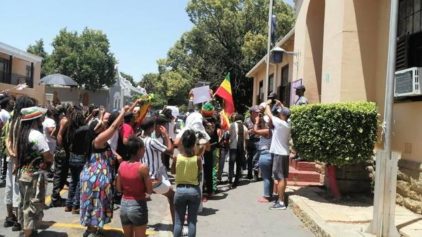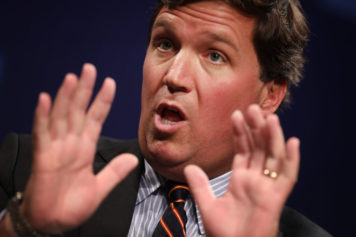Shaking his fist and surrounded by angry colleagues, South African gold miner Chres Manyaka raged against ‘fat cats’ getting rich from the sweat of the workers.
But he was not talking about managers of the Gold One company, which had sacked him and several other fellow workers for an illegal strike at the mine east of Johannesburg.
Manyaka’s tirade was against bosses of the National Union of Mineworkers (NUM), a pillar in the trade union alliance that brought workers to the fight against apartheid and helped carry the African National Congress (ANC) to power in 1994 in the continent’s largest economy and No. 1 platinum producer.
“If you go and see the NUM people you can see the big stomachs. NUM now is like management,” 28-year-old Manyaka said outside Gold One’s entrance, fringed by the blue gum trees whose timber has been used for beams in South African mines.
Complaints that the NUM, which remains a buttress of political and electoral support for the ruling ANC-led alliance, is not defending the interests of its rank and file have put the legendary labor grouping under siege.
Aggressive upstart unions have been poaching NUM members in often violent turf wars waged from the shantytowns ringing the world’s largest platinum mine to smaller gold producing pits.
The ANC, which has governed since the end of white rule in 1994, starting under the magnetic leadership of Nelson Mandela, still looks unrivaled in the political sphere.
But the groundswell revolt against the NUM is tapping into the same popular discontent with poor government delivery of services that is confronting the ANC.
“There isn’t a challenge to the ANC yet but there is an indication of where that challenge is going to come from, and that is an alternative labor movement,” said Gary van Staden, political analyst with NKC Independent Economists.
This should be a concern for President Jacob Zuma as NUM, with its roughly 300,000 members and through its Congress of South African Trade Unions mother body, is a key backer of his bid for a second term as leader of both the ANC and the nation.
ANC leaders are aware that elsewhere in southern Africa, the strongest challenges to liberation movements turned ruling parties have emerged from urban and mining-based trade unions.
The most telling example can be found right next door in Zimbabwe, where the Movement for Democratic Change (MDC) that shares a turbulent coalition government with President Robert Mugabe’s ZANU-PF party grew out of unions and the urban poor.
“WE DON’T DO POLITICS”
In their assault against the NUM, brash smaller challengers like the Association of Mineworkers and Construction Union (AMCU) and the Professional Transport & Allied Workers Union (PTAWU), have been hammering away at what they scent is its weakest spot.
Just like many ANC bigwigs in government, NUM heavyweights now face accusations from their restless membership that they spend more time looking after their own interests than improving the lot of ordinary workers.
“The NUM, they see that the train is moving so they lose the plot. Our friends are getting rich. So the focus is no longer with the workers,” said AMCU president Joseph Mathunjwa.
Past NUM leaders who are ANC heavyweights include Cryil Ramaphosa, a business tycoon with interests in the mining sector who today is one of South Africa’s richest men.
And while NUM leaders recently attended a glittering gala dinner with mining company executives early in June, their rivals are working the crowded urban centers, townships and pitheads in their campaign to poach NUM members.
The offices of the union that Manyaka and other NUM defectors joined, the Professional Transport & Allied Workers Union (PTAWU), are sparsely furnished in a rundown part of Johannesburg’s city center.
“We focus on labor issues. We don’t do politics,” said PTAWU general secretary Reckson Baloyi.
Accused by detractors of using strongarm tactics that have sometimes led to turf fights and even deaths, AMCU has been taking on the NUM in townships and mines.
It last year challenged the dominant mineworkers’ union at the Karee Mine operated by the world’s third largest platinum producer Lonmin. It is now recognized there and managed to wrest at least 3,400 members from NUM.
It then waded into the Rustenburg operations of world No. 2 platinum producer Impala Platinum and the wildcat strike and fighting that erupted there shut 15 percent of the global supply of the precious metal for 6 weeks this year, driving its spot price higher.
Implats officials say it looks like AMCU now claims about half of the 20,000 unionized workers there but an independent audit needs to verify this. If true, it will mean AMCU has poached about 5 percent of NUM’s members in the past few months.
DELIVERING – OR NOT
Just as NUM’s rivals lambast the trade union for “failing to deliver”, so the ANC government has faced hundreds of protests in poorer communities and townships against deficiencies and shortages in the supply of electricity, water, sanitation, public transport and health and education services.
An example of such potentially explosive discontent can be found in the Zandspruit squatter camp on the northern edge of Johannesburg, where riots periodically erupt among residents fed up with a lack government services.
“People want homes, electricity, roads and toilets. They have been promising for too long and they do nothing,” said Tshepo Ramapoka, 43, a self-employed building contractor who lives in the settlement.
He was speaking the day after the latest protests as city workers cleaned up the rock- and brick-strewn streets under the watchful eyes of heavily-armed police. The charred remains of burnt tires were strewn about.
Most of Zandspruit’s residents live in wretched conditions in makeshift corrugated iron homes which have been jumbled together in a maze of dirt roads covered in trash.
Speaking at an ANC policy conference last week, President Zuma acknowledged the anger displayed in so-called “service delivery” protests and said the government must address it.
“You can’t sit and say ‘it’s fine’. We are in government, we have to do something about it,” Zuma said.
A DECENT WAGE?
Growing mineworkers’ frustration with NUM may send a chill up the spine of corporate boardrooms because the main union has consistently won above-inflation wage hikes for its members.
“Every time we go to bargaining it is not about the ANC, it is about the issues raised by our members. And we are delivering double-digit pay increases,” NUM general secretary Frans Baleni told Reuters, rejecting the accusations against union leaders.
But even a 10 percent raise may seem paltry when seen from the bottom of the scale in a country where economic inequality is among the highest in the world and where the typical mineworker on average has 8 dependents.
Outside Gold One’s premises, a crowd of angry workers showed a Reuters correspondent a pay slip.
The monthly gross earnings shown on it were 3,746.78 rand ($460), the take-home pay 2,659.26 rand ($330).
Across the industry there are wide disparities in pay and many unskilled or semi-skilled workers make between 3,500 to 5,000 rand a month for dirty and dangerous work. Mining companies say costs across the board are rising and that they cannot afford to significantly hike wages and remain profitable.
Average gross monthly earnings in mining in February were around 14,000 rand, according to the latest quarterly employment report from Statistics South Africa.
The average national monthly earnings for all non-farm sectors was just slightly lower than this but the median figure for mining masks the stark differences between the lower and higher ends of the pay scale in the industry.
PTAWU failed in its bid to gain recognition at Gold One and hundreds of employees who took part in an illegal strike were dismissed by management. But their anger was directed at NUM.
One deduction in the pay slip was 28.75 rand for a NUM subscription, which infuriated the sacked workers.
“Even when we say we have quit NUM, management still forces us to pay them!” one shouted. ($1 = 8.0905 South African rand)
Source: Reuters


